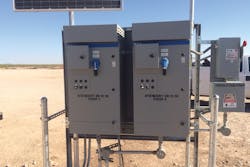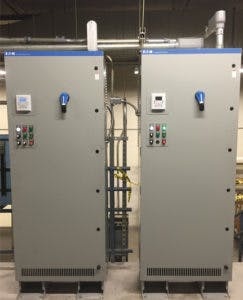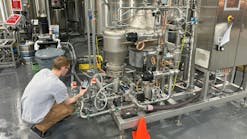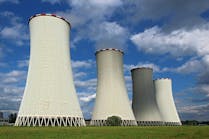Using variable frequency drives to control HVAC/R applications
Expanding population, codes and regulations, connectivity and monitoring are directly affecting HVAC/R equipment requirements and market growth. More equipment is needed for new project construction, required retrofits and building expansions. Just because more or new equipment is required does not always mean the total cost of ownership must increase. This is where energy efficiency plays a role — and it has never been more important.
Variable frequency drives (VFDs) have been a vehicle for improving a system’s energy efficiency for over 40 years. By incorporating VFDs into pump systems, engineers are able to significantly decrease the overall cost of the system. A standard VFD controls a motor based on a linear volts per hertz (V/Hz) relationship. The output voltage waveform of a standard VFD is typically based on pulse-width modulation (PWM). The amplitude, duty cycle and periodicity of the PWM waveform decide the effective voltage and frequency of the VFD output.
However, this is not enough anymore, especially for fan and pump motors in HVAC/R applications or variable torque applications. In these applications, the speed of the motor is reacting to external sources that are a part of the overall system. These external sources could be a temperature sensor in a refrigeration system, a humidity sensor in a data center facility or a pressure sensor monitoring the room pressure in a clean room. A VFD uses the external sources as input data to adjust the output frequency to the motor, in turn, adjusting the speed of the motor. In these applications, there are advantages to varying speed rather than running at 60 Hz, full load amps, at all times. The following are three additional considerations to reduce energy costs and become more energy efficient.
Energy optimization software
A standard VFD modulates the output voltage waveform to adjust the output frequency. With new technologies in current VFDs, more can be done to optimize the energy consumption in variable torque applications than just standard V/Hz control.
Many VFDs have optimization parameters that can be used to tune the input power consumption while maintaining the load’s torque or speed demand. However, some VFDs have built-in algorithms that can conduct the tuning and monitoring automatically, for example, Eaton’s Active Energy Control technology.
This algorithm works right out of the box — no tuning or adjusting of parameters is required. The algorithm monitors the output power performance while reducing the input power requirement. To ensure the stability of the motor, the algorithm initially sets the drive output voltage at the same level as the voltage based on the linear V/Hz method for the same reference frequency. It then begins to reduce the voltage incrementally to optimize the energy usage. Meanwhile, the algorithm monitors several real-time parameters of the motor to prevent the motor from entering conditions that may lead to instability. When the motor enters the optimal zone of operation, the drive output voltage stays at the same level until there is a change triggered by commands to the drive, such as a change in the reference frequency or a change in some real-time parameters. After the output voltage stabilizes, the drive keeps monitoring the real-time parameters of the motor to prevent instability conditions.
The VFD built-in algorithm can save energy costs up to 10% compared to standard VFDs as the algorithm is actively monitoring and consistently running the optimization algorithm at all times. This is big savings to realize for systems with multiple loads and the added benefit of no additional adjustments required to maintain the system’s performance and reliability.
Eaton’s Enclosed PowerXL DG1s installed in a mechanical room.
Electronic bypass control
Many HVAC/R applications are mission critical to a building or facility’s processes. It is suggested to improve the reliability of the system to have a bypass circuit in parallel with the VFD circuit. The bypass circuit provides redundancy to the primary VFD circuit in case of failure or fault conditions. Bypass circuits can include contactors, reduced voltage soft starters or another VFD. The following are examples of these methods.
Contactors are most commonly used because they are compact in size, reliable and inexpensive. While in bypass mode, the contactors would run the motor at full load amps. No energy savings are seen during contactor bypass mode.
Reduced voltage soft starters are a bypass option for motors that tend to have high inrush currents that can damage mechanical components in the motor or equipment such as water hammer in pumps. The soft starter is able to ramp up the current and eliminate this high inrush current. The soft starter, like the contactor, would run the motor at full load amps once the current ramp process to full load amps is completed.
VFDs are becoming a specified bypass solution to provide the highest level of redundancy. The VFD bypass circuit can control the system in the same manner as the primary VFD and continue to communicate to the building management system. By using a VFD bypass circuit, operators can resume the energy efficiency and savings similar to the primary VFD.
These three methods of bypass can be controlled two ways — manually or electronically. Manual bypass control allows a user to switch the VFD into bypass mode or back into VFD mode through a position switch or buttons. This method provides the user a physical control mode, but the control is local to the VFD and manual.
Electronic bypass allows the bypass mode to be controlled by the VFD or an external controller. The controller or VFD can receive signals and electronically put the VFD into bypass mode and close the bypass circuit. Signals could originate from a digital input from a sensor via communication from the building management controller or from the VFD keypad for local control. This improves the monitoring capability and system processes while reducing the overall cost of the VFD product by removing pilot devices from the front of the enclosure and the labor to assemble.
By using a VFD with built-in electronic bypass, a facility can further reduce the cost of the product since the external controller is not required. Operators can also add functionality to go into bypass mode in a fault condition, providing even more system process protection and increased system reliability.
Utility rebate programs
As energy demands rise, utilities are offering rebate programs to industrial customers to promote the use and installation of energy-efficient products that can help reduce the energy footprint. These programs include rebates for LED lighting or smart lighting controls, solar PV arrays and efficient HVAC/R equipment and controls — including VFDs — to encourage facilities to upgrade equipment to a more energy-efficient solution. The initial capital cost of installing the new solutions can be offset by the rebate and the long-term energy savings. VFDs alone can provide a 60% energy savings over standard across-the-line starters.
Energy saving calculators can help estimate the long-term cost of a VFD versus a starter. The calculator evaluates the typical fan or pump duty cycle, the initial cost of the VFD and the motor efficiencies. It provides a report on the energy saved and reduced carbon footprint. This report includes estimated payback time to better understand the effect of installing a VFD in place of a starter.
By using the utility rebate programs and the energy savings calculator, industrial facilities can see monetized benefits of installing a VFD to control HVAC/R applications.
Conclusion
Energy efficiency has become more important to facilities as a channel to achieve overall cost reductions. Energy is crucial to most applications, especially mission-critical HVAC/R applications. By optimizing the input power required to maintain output performance, using VFD integrated electronic bypass for improved reliability and taking advantage of rebates, VFDs installed on variable torque motors are an easy solution to reduce energy cost, increase energy efficiency and improve systems reliability and monitoring.
Seth O’Brien is the product manager, HVAC variable frequency drives, Industrial Controls Division at Eaton. He has five years of experience with Eaton in sales and marketing roles. O’Brien is responsible for Eaton’s HVAC strategy, including new product development and sales execution. He holds a bachelor’s degree in mechanical engineering from the University of Florida and is an MBA candidate with the University of Wisconsin.




